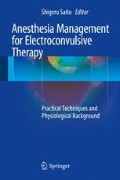Abstract
It is quite important to induce qualitatively effective seizure electroencephalogram (EEG) under proper sedation, respiratory management, and cardiovascular stability for safe and therapeutically effective electroconvulsive therapy (ECT).
However, avoidable circulatory and respiratory complications during ECT still occur. Besides, failure to induce qualitatively effective seizures is still relatively common.
Therefore, it is necessary to develop methodologically rational anesthesia management based on proper and comprehensive judgment of multifarious information from various monitors and computer simulation software, such as transitional changes in plasma and effect-site concentrations of intravenous anesthetics, to increase the safety and efficacy of ECT.
In this chapter, we will introduce our practical anesthesia procedures for ECT and compare them to those traditionally used. Moreover, we will expound the significance to the optimal use of various monitors, devices, and computer simulation software, which are already brought into clinical application, while explaining their special characteristics and important points to notice.
Furthermore, we will summarize current methods for qualitative evaluation of seizure EEG.
Access this chapter
Tax calculation will be finalised at checkout
Purchases are for personal use only
References
Saito S. Anesthesia management for electroconvulsive therapy: hemodynamic and respiratory management. J Anesth. 2005;19(2):142–9.
Poulet E, Auriacombe M, Tignol J. Seizure threshold and ECT. Importance for good clinical practice of ECT. A review of literature. L’Encéphale. 2002;29(2):99–107.
Schüttler J, Ihmsen H. Population pharmacokinetics of propofol: a multicenter study. Anesthesiology. 2000;92(3):727–38.
Kern SE, Xie G, White JL, Egan TD. A response surface analysis of propofol–remifentanil pharmacodynamic interaction in volunteers. Anesthesiology. 2004;100(6):1373–81.
Johnson KB, Syroid ND, Gupta DK, Manyam SC, Egan TD, Huntington J et al. An evaluation of remifentanil propofol response surfaces for loss of responsiveness, loss of response to surrogates of painful stimuli and laryngoscopy in patients undergoing elective surgery. Anesth Analg. 2008;106(2):471–9, table of contents.
Koitabashi T, Johansen JW, Sebel PS. Remifentanil dose/electroencephalogram bispectral response during combined propofol/regional anesthesia. Anesth Analg. 2002;94(6):1530–3.
Kurita T, Morita K, Kazama T, Sato S. Influence of cardiac output on plasma propofol concentrations during constant infusion in swine. Anesthesiology. 2002;96(6):1498–503.
Frölich M, Dennis D, Shuster J, Melker R. Precision and bias of target controlled propofol infusion for sedation. Br J Anaesth. 2005;94(4):434–7.
Nishihara F, Ohkawa M, Hiraoka H, Yuki N, Saito S. Benefits of the laryngeal mask for airway management during electroconvulsive therapy. J ECT. 2003;19(4):211–6.
Saito S, Kadoi Y, Nihishara F, Aso C, Goto F. End-tidal carbon dioxide monitoring stabilized hemodynamic changes during ECT. J ECT. 2003;19(1):26–30.
Gajwani P, Muzina D, Gao K, Calabrese JR. Awareness under anesthesia during electroconvulsive therapy treatment. J ECT. 2006;22(2):158–9.
Kurnutala LN, Kamath S, Koyfman S, Yarmush J, SchianodiCola J. Aspiration during electroconvulsive therapy under general anesthesia. J ECT. 2013;29(4), e68.
Zibrak JD, Jensen WA, Bloomingdale K. Aspiration pneumonitis following electroconvulsive therapy in patients with gastroparesis. Biol Psychiatry. 1988;24(7):812–4.
Aksay SS, Bumb JM, Janke C, Hoyer C, Kranaster L, Sartorius A. New evidence for seizure quality improvement by hyperoxia and mild hypocapnia. J ECT. 2014;30(4):287–91.
Streisand JB, Bailey PL, LeMaire L, Ashburn MA, Tarver SD, Varvel J, et al. Fentanyl-induced rigidity and unconsciousness in human volunteers incidence, duration, and plasma concentrations. Anesthesiology. 1993;78(4):629–34.
Duarte LTD, Saraiva RÂ. When the bispectral index (bis) can give false results. Rev Bras Anestesiol. 2009;59(1):99–109.
Zanner R, Pilge S, Kochs E, Kreuzer M, Schneider G. Time delay of electroencephalogram index calculation: analysis of cerebral state, bispectral, and Narcotrend indices using perioperatively recorded electroencephalographic signals. Br J Anaesth. 2009;103(3):394–9.
Barnard J, Bennett C, Voss L, Sleigh J. Can anaesthetists be taught to interpret the effects of general anaesthesia on the electroencephalogram? Comparison of performance with the BIS and spectral entropy. Br J Anaesth. 2007;99(4):532–7.
Tang W-K, Ungvari GS. Asystole during electroconvulsive therapy: a case report. Aust N Z J Psychiatry. 2001;35(3):382–5.
Koga Y, Mishima Y, Momozaki M, Hiraki T, Ushijima K. A case of nonsustained ventricular tachycardia immediately following modified electroconvulsive therapy in a depressive patient. J Anesth. 2011;25(4):595–8.
Takano H, Motohashi N, Uema T, Ogawa K, Ohnishi T, Nishikawa M, et al. Changes in regional cerebral blood flow during acute electroconvulsive therapy in patients with depression Positron emission tomographic study. Br J Psychiatry. 2007;190(1):63–8.
Sackeim HA. The anticonvulsant hypothesis of the mechanisms of action of ECT: current status. J ECT. 1999;15(1):5–26.
Sakurai K, Takeda Y, Tanaka N, Kurita T, Shiraishi H, Takeuchi F, et al. Generalized spike-wave discharges involve a default mode network in patients with juvenile absence epilepsy: a MEG study. Epilepsy Res. 2010;89(2):176–84.
Holmes MD, Brown M, Tucker DM. Are “generalized” seizures truly generalized? Evidence of localized mesial frontal and frontopolar discharges in absence. Epilepsia. 2004;45(12):1568–79.
Edward C, Coffey M. The ictal EEG as a marker of adequate stimulus intensity with unilateral ECT. Neurosciences. 1995;7:295–303.
Nobler MS, Sackeim HA, Solomou M, Luber B, Devanand D, Prudic J. EEG manifestations during ECT: effects of electrode placement and stimulus intensity. Biol Psychiatry. 1993;34(5):321–30.
Motohashi N, Awata S, Isse K, Ueda S, Okubo Y, Okumura M, et al. Recommendation for ECT practice, Second edition. Psychiatria et neurologia Japonica. 2013;115(6):586–600.
Folkerts H. The ictal electroencephalogram as a marker for the efficacy of electroconvulsive therapy. Eur Arch Psychiatry Clin Neurosci. 1996;246(3):155–64.
McCall WV, Robinette GD, Hardesty D. Relationship of seizure morphology to the convulsive threshold. J ECT. 1996;12(3):147–51.
Acknowledgment
We would like to thank every psychiatrist, internist, pharmacist, nurse, and all of the staff daily engaged in clinical support of ECT in Kouseikai Kusatsu Hospital.
Author information
Authors and Affiliations
Corresponding author
Editor information
Editors and Affiliations
Rights and permissions
Copyright information
© 2016 Springer Japan
About this chapter
Cite this chapter
Demoto, Y. (2016). Comprehensive Monitoring During Procedures Under Reasonable Anesthetic Control. In: Saito, S. (eds) Anesthesia Management for Electroconvulsive Therapy. Springer, Tokyo. https://doi.org/10.1007/978-4-431-55717-3_2
Download citation
DOI: https://doi.org/10.1007/978-4-431-55717-3_2
Published:
Publisher Name: Springer, Tokyo
Print ISBN: 978-4-431-55716-6
Online ISBN: 978-4-431-55717-3
eBook Packages: MedicineMedicine (R0)

